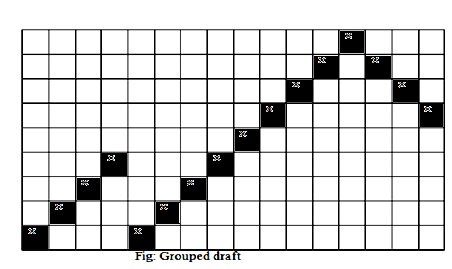SYSTEM AND CLASSIFICATION OF DRAFTING IN WEAVING:-
System and Classification of Drafting in Weaving:-
DRAFTING IN WEAVING:-
Drafting in weaving means the number of heald shafts used to produce a given design and the order is which warp ends are threaded through the heald eyes of the heald shaft. The principle of drafting is that ends which work in different order require separate heald shafts.
System or classification of drafting in weaving:-
Drafting are of following types:
Straight draft
Skip draft
Broken draft
Group draft
Pointed draft /V- draft
Curved draft
Divided draft
Combined draft
Sateen draft
Bed fort cord draft.
1) Straight Draft:-
This draft is the simplest types of draft and from the basis of many others drafts. There each successive thread is drown on each successive shaft. The first thread is drowned through the first heald shaft and the second through the second heald shafts and so on. So, the no. of heald shafts equals the no. of warp threads in a repeat.
Straight drafts are two types:
1) S-entering
2) Z- entering
Fig: types of Straight draft (above two drafts)
Uses:- Used in twill design.
2. Skipped Draft:-
This draft is used in weaving the fabrics with a high density of warp threads. Here the number of heald shafts used is two or more times greater than the maximum number of heald shafts required this draft is used in plane weave fabrics.
The advantages of using this drafting system are:
Less friction
Less crowding threads
Less end breakage
Uses:-This system is particularly useful in weaving very densely fabric.
3. Pointed draft /V- draft:
Point drafts are used for the weaves which are symmetrical about the center. This draft is produce in case of waved or diamond effects on fabric. In this system a straight draft is returned in the opposite direction .Here the first and last heald shafts of design contain only one end whereas the middle shafts contain warps.
3) Pointed Draft:-
Here, the number of heald shafts is always one more then the haft of the number of warps in warp.
4. Broken draft:-
This draft may be considered as modified pointed draft. It is also a combination straight drafts of different direction of construction. In broken draft a break in continuation occurs where the warp thread revers its direction. This direction is reversed not on the last on first shaft as in pointed draft. The broken draft is applied for producing herring bone, twill, diaper designs etc.
Uses:-
This draft is applied for producing herringbone twills, diaper design and etc.
5. Divided Draft:-
In this draft the heald shafts are divided into two or more groups. For every groups suitable draft is selected in pile weave two or more sets of warp thread are used. So, they require this type of draft. For example: The ground of warp thread of warp pile fabric are passed through the front heald shafts and pile warp thread are passed through the back heald shafts.
Uses:The draft is employed for derived weaves, double warp weaves, two ply weaves, pile weaves etc.
6. Grouped Draft:-
This type of draft is used for producing cheek and stripe fabric, in which strips have different weaves or there combination.
Here in example the first 4 threads of warp are responsible for one type of strip and the next thread are for another strip.
Uses: This draft is used for producing check and stripe fabric.
7. Curved Draft:-
This draft is applied fancy weave having large warp repeat with a view to reduce the number of heald shafts. There are irregular and actually cannot be classified.
Fig of Curved Draft in weaving:6)-
In word it may be regarded as a type of pointed draft. But where number fixed pick point will occur.
Uses: Used to produce decorated weave with large repeat unit.
8. Combined Draft:-
Various methods of drawing in can be combined in one draft for producing a certain type of fabric. Two or more drafts described above can be applied simultaneously, for example, straight and skip or sateen, grouped and curved, and so on. Combined draft is the most complicated and can be chosen only if there are some technological or economic reasons. The designer having a great experience can do it properly.
Uses: In producing some special type of fabrics different type of drafts are required to be mixed.
Ref:-https://textilelearner.net.










Comments
Post a Comment